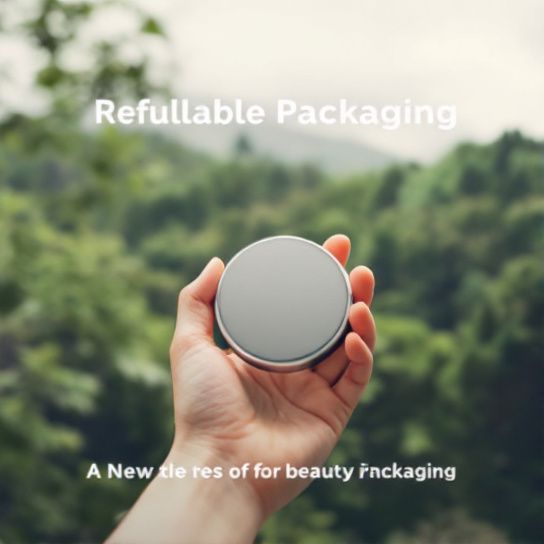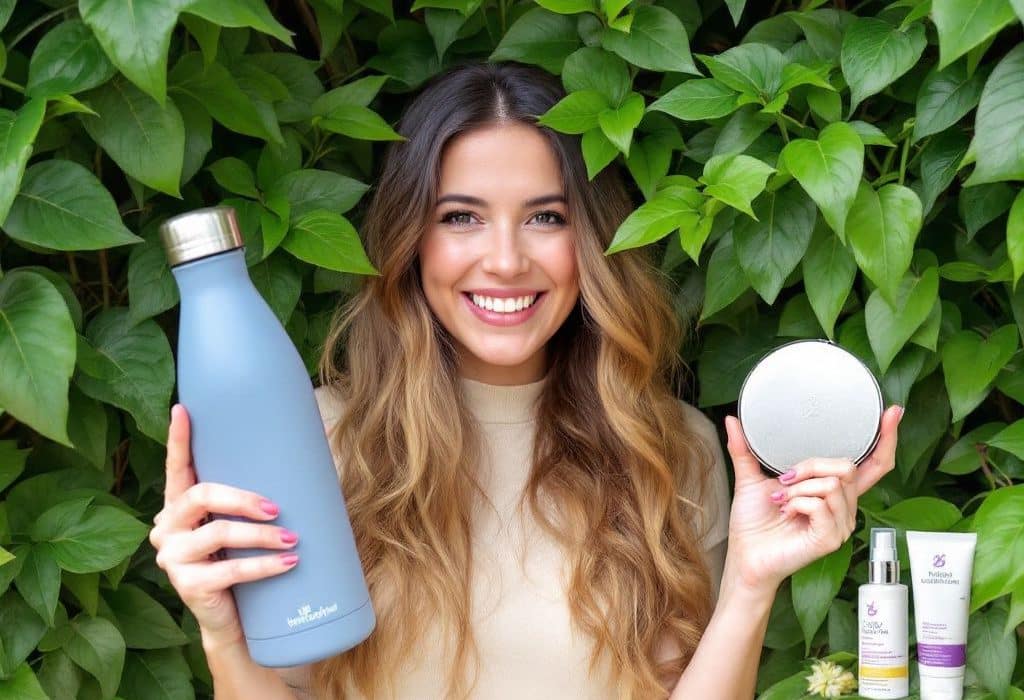The beauty industry is experiencing a green overhaul as sustainability takes center stage. Today’s beauty enthusiasts are more informed and eco-conscious than ever, demanding products and practices that don’t just make them look good but also lessen environmental impact. As we navigate this evolving landscape, social media acts as a powerful catalyst, amplifying sustainable beauty trends to a global audience. Let’s dive into some of the most influential eco-friendly beauty practices that are reshaping our beauty routines in 2025. 🌍💚
1. Upcycled Beauty: Turning Waste into Wonder
Embrace Circular Economy with Skincare 🍊
As landfills swell, the beauty industry is tapping into the potential of upcycling, a practice that transforms waste materials into high-value products. Think ground coffee beans as exfoliants or fruit pits repurposed into face oil bases. Major brands are leading the way with innovations; for instance, brands like UpCircle are crafting perennial favorites using repurposed by-products, offering high-performing and eco-friendly alternatives.
**How It Works:** Upcycling not only reduces waste but also utilizes resources that would have been otherwise overlooked. This boosts both sustainability and efficiency in product manufacturing.
**Practical Tip:** Before discarding your morning brew, rethink its potential beauty benefits. Coffee grounds and coconut oil can create a homemade body scrub that’s good for your skin and the planet alike.
2. Waterless Beauty: Conserving Our Most Precious Resource
More Concentrate, Less H2O 🌊
Water scarcity is an increasing global concern, and the beauty world is adapting with innovation by moving towards waterless products. From powdered cleansers to solid shampoos, reducing water content conserves resources and often boosts product potency.
**Example:**
- Powder to Foam Cleansers: Brands like Lush offer temptations with their solid formulations that last longer and don’t require large volumes of water in production.
**Actionable Advice:** Choose waterless products wherever possible, maximizing hydration while minimizing environmental impact. Your hair and skin will thank you for more concentrated, nutrient-rich formulations.

3. Refillable Packaging: The Future of Product Reuse
Closing the Loop on Packaging 📦♻️
Tackling packaging waste head-on, refillable containers are becoming the norm in conscious cosmetic circles. Rather than tossing away product packaging, consumers can now refill their containers with product just as easily, minimizing plastic waste and carbon footprint.
**Industry Insight:** Pioneers such as Kjaer Weis, renowned for their chic metal compacts, emphasize both aesthetics and eco-friendliness.
**Do This, Not That:** Opt for brands offering innovative refill programs—an elegant compact that you own long-term not only feels premium but reduces waste with each use.
4. Minimalism in Beauty: The Rise of Skinimalism
Do More with Less: Streamlined Skincare 🧴
Skincare minimalism, often hashtagged as #skinimalism, promotes streamlined beauty routines focusing on fewer, multi-tasking products. This rebalances personal care with sustainability as consumers gravitate towards essentials that reduce over-consumption and decrease product waste.
**Trend Watch:** Meld beauty with efficiency, utilizing hybrid products like tinted moisturizers with SPF, thereby cutting down on the number of items you need without compromising on results.
**Common Mistakes to Avoid:** Over-layering not only weighs down the skin but often diminishes product efficacy. Experts recommend quality over quantity—your vanity and skin ecosystem deserve it.
5. Plant-Based and Biotech Alternatives: Cruelty-Free Commitments
Pioneering with Plants and Precision 🪴🔬
Vegan beauty has cemented its place, promoting plant-derived alternatives over traditional animal-based ingredients. Advanced biotech is pushing further, lab-engineering identical beauty elements like collagen minus the cruelty.
**Case in Point:** Brands like Drunk Elephant blend sustainability and science by formulating without essential oils, drying alcohols, and sulfates—but with completely vegan squalane sourced from sugarcane.

**Best Practice:** Transition to a vegan and plant-based product range and support brands that bolster ethical, science-backed alternatives that are vegan-certified.
6. Transparent Beauty: Informed Choices through Product Labeling
Decipher Labels with Accuracy 🏷️🔍
Transparency in ingredient sourcing and labeling arms consumers with the knowledge to make informed, eco-responsible choices. Information is power, and the trend towards crystal-clear ingredient disclosures provides a measure of credibility and trustworthiness in an often-cluttered market.
**Real-World Scenario:** Think clean beauty stalwarts like Honest Beauty, labeling free from anything unpronounceable and laying bare every ingredient sourced.
**Pro Tip:** Study label language, understand what each ingredient does, and align product choices with researched insights that mitigate environmental impact.
7. Green Chemistry: Innovating Beauty for the Environment
High-Performance Formulation, Low Environmental Footprint 🧪
Green chemistry proposes an elevated way of concocting products, focusing on sustainable ingredients and environmentally benign processes. This leads to products that deliver effective results without the eco-drawbacks of conventional processes.
**Example of Innovation:** Indie and larger companies are now creating potent products without the hefty carbon footprint, decoding effective alchemy that doesn’t compromise Earth. Tata Harper beauty is applauded for incorporating 100% natural and non-toxic ingredients cultivated with environmental integrity.
**Actionable Guide:** Prioritize purchases from brands that commit to ethical sourcing. Often, these brands will demonstrate a full life cycle approach, mitigating not only manufacturing impact but disposal consequences.
8. Biodegradable Skincare: Earth’s Friendly Formulations
Letting Nature Take Its Course 🌿

Biodegradable cosmetics break down harmlessly after use, leaving no toxins that harm the earth. This is an evolving sector aiming to circumvent traditional beauty waste.
**Statistics:** The Environmental Working Group emphasizes both the elimination of microplastic pollution and conservation via fully degradable packaging and formulas, catalyzing environmental ease.
**Adoption Tip:** Before ditching sachets, seek out brands with certifications like ‘Ecocert’—ensuring holistic biodegradability as part of their DNA.
9. Virtual Try-Ons: Bridging Technology and Sustainability
Shop Smarter without the In-Person Waste 📲
Augmented reality (AR) allows consumers to try before they buy, cutting down on unnecessary sampling that leads to waste. With AR, users can engage with an unlimited potential product demo library that’s zero-waste.
**Example:** Sephora’s Virtual Artist tool lets users self-style and experiment without rinsing off in front of human guilds—a modern approach to sustainability.
10. Ethical & Inclusive Sourcing: Beyond Ingredients
Diversity, Equity, and Inclusion in Beauty 🙌
Beyond eco-friendly ingredients, sustainable sourcing now entails inclusivity and ethical labor practices, supporting fair trade and equity in sourcing raw materials.
**Illustration of Change:** Brands like The Body Shop echo fair trade ethos, sourcing shea, sesame seed oils, and cocoa butter through community commerce programs that elevate the narratives of marginalized local farmers.
**Final Thought:** Favor brands fostering inclusive value chains and witness the sustainable growth of communities—advocating for ethical approaches ensures a genuine trifecta of person-planet-profit.
—
Incorporating sustainable beauty practices is a profound shift in sentiment and action towards environmental responsibility—with social media platforms accelerating dissemination and adoption of eco-cognizant techniques, especially through viral beauty hacks. The trends of 2025 encourage not just green consumption but integrated mindfulness that embraces innovation and ignites paradigm shifts in conscious engagement. By channeling these behaviors into daily beauty practices, we don’t just reflect care and enterprising elegance for our skin and strands but participate in restorative metamorphosis for a healthier planet. 🌱
Now, the ball’s in your eco-friendly court! Adopt these sustainable beauty trends into your routine, and you’ll be a part of a larger movement making waves on more than just social media but within the very essence of beauty itself, reshaped under uvulas of green and organic ethos.
Frequently Asked Questions
What are the benefits of using a hair mask in my hair care routine?
Using a hair mask can provide several benefits, including hydration, smoothing, strengthening, curl definition, heat protection, and damage repair. Hair masks infuse the hair with moisture, help coat the hair shaft to seal split ends, reduce breakage, and protect the hair from heat styling and environmental damage[1][4].
What ingredients should I look for in a hair mask?
Effective hair masks often include ingredients such as coconut oil, argan oil, shea butter, honey, avocado oil, green tea, and coconut water. These ingredients provide nourishment, moisturize, and protect the hair, offering benefits like softening, moisturizing, and protecting against damage[2][5].
How often should I use a hair mask in my routine?
You should use a hair mask whenever your hair feels dry, unmanageable, or in need of intense hydration. This can vary depending on your hair type and needs, but generally, using a hair mask once or twice a week can help maintain healthy and moisturized hair[1][4].
How do I apply a hair mask for the best results?
To apply a hair mask effectively, shampoo your hair first, then apply the mask, focusing especially on the ends where hair tends to be the most damaged. Leave the mask on for anywhere from 10 minutes to overnight, depending on the type of mask and your hair’s needs[1][4].
References


